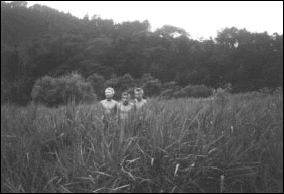|
|
| Director, Photography, Editing, Sound: Oki Hiroyuki Music: Imai Tsutomu, Yoshino Hiroshi, Saito Tetsu, Joëlle L?andre, Imahori Tsuneo, Shichiseikai Producer: Echigoya Takashi Production Company: Image Forum Fudosan Kaikan Bldg. 6F, 3-5 Yotsuya Shinjuku-ku, Tokyo 160-0004 JAPAN Phone: 81-3-3357-8023 / Fax: 81-3-3359-7532 Source: Aichi Arts Center 1-13-2 Higashi-Sakura Higashi-ku, Nagoya, Aichi 461-0005 JAPAN Phone: 81-52-971-5511 / Fax: 81-52-971-5644 JAPAN / 1997 / Japanese / Color / 16mm / 82 min |
Born in Tokyo in 1964. Graduated from the Architectural Department of the Faculty of Engineering of Tokyo University in 1988. Studied film production at the Image Forum Institute of the Moving Image and was recognized for his 3 hour long thesis film The Film of Buddy Matsumae ("Matsumae-kun no eiga," 1989). His film Swimming Prohibited ("Yuei Kinshi," 1989) won the Special Juror's Prize at the 1990 Image Forum Festival. Moved to Kochi city in 1991, and in 1992 directed the Jurgen Brunning production Tarch Trip ("Tachi torippu," 1993). Directed his first 35mm fiction film I Like You, I Like You Very Much ("Anata ga suki desu, daisuki desu") in 1994. In 1996 his Heaven-6- Box, a production of the Kochi Museum of Art, was given a NETPAC Special Mention at the 1995 Berlin International Film Festival. Recently he has been involved in live music sampling at screenings of his work. |
 |
|
| Despite its uncomplicated composition as a film recording 82 minutes
of performance art in a single continuous shot with a mini-cam,
3+1 is a colorfully work expressive. This is due to the film's multi-layered
structure born of the filmmaker being performer, documentarian,
and also the creator of the images we see projected onto the stage
itself. Rather than being separated, these levels are beautifully
integrated into one work. 3+1 is somewhat different from the quiet and instropective tone of
Oki's previous films. Lively images take us from dressing rooms
to audience to stage. It is a radical departure from the techniques
of conventional live performance documentaries. Technically speaking,
at a time when we are being flooded with digital image effects,
this film reverses some of the nasty habits of personal video
cameras and in so doing is extremely innovative. --Masuya Shuichi |
|
|
|
|
|
Director's Statement At the same time as I was in charge of the moving image section
of the collaborative performance "Hill of Ships, Stage of Water"
(performed on September 24th, 1996). As a record of the performance,
I also produced the sixth original piece in the Aichi Arts Center
series. The commission first came to me in this mixed format.
In one sense such a work is complicated, and to other directors
it would probably seem like a really difficult plan to execute,
but since at that time I was interested in live performance, or
shall I say the relationship between the stage and film, I really
wanted to do it. I thought it seemed really interesting. However,
the truth is, I began without knowing what form it would take.
Then the image of "3+1" came to me with the idea of shooting on
location in Okinawa, Kochi, and Nagoya and adding images of the
public performance. Having been involved in the process of constructing
the performance, I feel that whilst the images from both the live
performance and the film were brought together in a multiplicity
of ways, what we wound up with is actually a movie that is structurally
very simple. |
|
